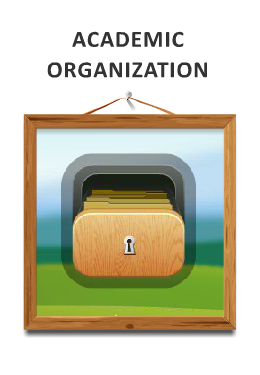Academic Organization
Academic Organization provides strategies to help students keep their binders, backpacks, and lockers organized. It also offers effective ways to manage their assignments online and in their daily planners. It includes four chapters: Introduction to Organization, Tracking Assignments, Organization at School, and Organization at Home.
This course introduces the following concepts:
- Chapter 1, Introduction, defines organization and teaches students to recognize the symptoms of being unorganized and identify the benefits of becoming more organized.
- Chapter 2, Tracking Assignments, provides strategies for effectively using a daily planner and for using a school management system.
- Chapter 3, Organization at School, introduces students to the SACHS system for organization (Sort, Arrange, Clean, Habit, Sustain) and provides examples for implementing it for binders, lockers, and backpacks.
- Chapter 4, Organization at Home, teaches students to create and maintain a homework station, develop a home filing system, create a file system on their computer, and implement the SACHS organization strategy to organize their bedrooms.
Each course features a glossary, pre- and post-tests, instruction on each topic, frequent knowledge checks to reinforce learning, Connect and Reflect activities to encourage student-parent interaction and allow students to connect the topic to their personal experiences.
Time Management
Time Management helps students understand how to use their time more effectively. Students are taught the four types of time traps, the importance of prioritizing, and backwards planning among other topics. It is composed of three chapters: Introduction to Time Management, Manage the Time You Have, and Time Traps.
This course introduces the following concepts:
- Chapter 1, Introduction, defines time management, explains the purpose and benefits, and teaches students to accurately estimate the time it takes to complete common tasks.
- Chapter 2, Manage the Time You Have, provides students with five steps to manage their time and introduces students to the four elements of self-management, the importance of writing all activities in one place, the backward planning model, and the purpose of prioritizing.
- Chapter 3, Time Traps, introduces students to the four types of time traps, explains methods to avoid procrastination, discusses the importance of planning for the unexpected, identifies ways to schedule efficiently, and teaches students to be more decisive.
Each course features a glossary, pre- and post-tests, instruction on each topic, frequent knowledge checks to reinforce learning, Connect and Reflect activities to encourage student-parent interaction and allow students to connect the topic to their personal experiences.
Study Skills
Study Skills offers students strategies for setting goals, active reading, taking notes, and studying for tests. Study Skills features five chapters: Goal Setting, Reading, Note Taking, Study Techniques, and Test-taking Strategies.
This course introduces the following concepts:
- Chapter 1, Goal Setting, teaches students the purpose of setting goals, explains the difference between long-term and short-term goals, teaches students to use SMART goals, describes the five steps of goal setting, and how to create SMART long- and short-term academic goals.
- Chapter 2, Reading, provides students with strategies for reading more effectively, helps students recall the factors that affect concentration, teaches students to apply the three types of reading (skimming, scanning, and reading for comprehension), explains the acronym ASR, and helps students apply the correct types of reading to prepare for a test.
- Chapter 3, Note Taking, introduces students to the proper method for listening in class, the importance of taking good notes, cues that indicate they should take notes, how to identify common abbreviations, and introduces them to method for efficient note taking.
- Chapter 4, Study Techniques, introduces students to common techniques to study effectively, explains the difference between short-term and long-term memory, how to identify their learning style, and explains how to determine which study techniques benefit each learning style.
- Chapter 5, Test Taking Strategies, provides students with strategies and tips for taking various types of tests, such as multiple-choice tests, short-answer, and essay tests.
Each course features a glossary, pre- and post-tests, instruction on each topic, frequent knowledge checks to reinforce learning, Connect and Reflect activities to encourage student-parent interaction and allow students to connect the topic to their personal experiences.
Social Citizenship
Social Citizenship teaches students the social skills for succeeding in middle school. Students learn how to communicate effectively, problem solve, manage stress, build character and ten essential character traits, how to deal with bullies and peer pressure, and cyber safety. This course includes four chapters: Life Skills, Character, Bullying
and Peer Pressure, and Cyber Safety.
This course introduces the following concepts:
- Chapter 1, Life Skills, introduces students to the six life skills (communication, teamwork, problem solving, critical thinking, personal responsibility, and stress management) and provides students with strategies to improve their abilities in each life skill.
- Chapter 2, Character, introduces students to the ten character traits students need to develop for success (conscientiousness positive mindset, kindness, self-control, honesty, perseverance, gratitude, curiosity, passion, and forgiveness) and provides strategies for developing these character traits.
- Chapter 3, Bullying & Peer Pressure, introduces students to the proper method for identifying bullying behavior, helps them recognize ways to prevent or deal with bullying. This chapter also teaches students to deal with peer pressure.
- Chapter 4, Cyber Safety, provides students with strategies to protect themselves while using the internet.
Each course features a glossary, pre- and post-tests, instruction on each topic, frequent knowledge checks to reinforce learning, Connect and Reflect activities to encourage student-parent interaction and allow students to connect the topic to their personal experiences.












